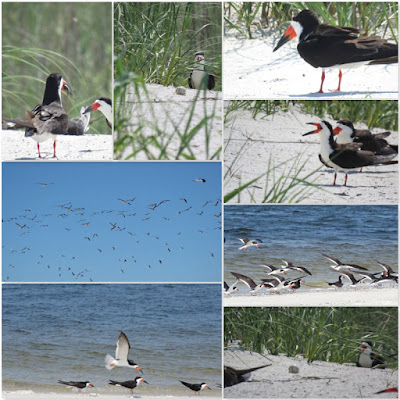 |
| Black Skimmer nest with 2 eggs!! (photo by Bill Segur) |
We have news to brighten your day! Our NC Audubon biologist, Lindsay Addison, conducted a NEST CENSUS early this morning.
First thing you need to know is the difference between a “nest check” and a “nest census". Lindsay has been doing "nest checks" regularly since the beginning of the season.
NEST CHECK
A nest check is a sampling of nests marked with tongue depressors at the beginning of nesting to enable the biologist to follow up on the activity of that particular nest. A number is assigned to the nest, such as BS 02 which marks a Black Skimmer nest #2, CT for Common Tern, etc. These labeled nests are checked on a regular basis to follow laying of eggs, loss of eggs, and anticipation of hatching. It also enables us to determine eggs that are abandoned (nonviable) and predated by gulls or crows because they were obviously pecked. Lindsay has been following between 16-30 nest.
 |
| Common Tern nest with tongue depressor label to the left |
As you know, we have lost many nests to crows and gulls, but the Black Skimmers, Common Terns and American Oystercatchers have kept re-nesting!
NEST CENSUS
A nest census is conducted when the biologist feels that we are at the peak of nesting…which Lindsay did this morning at 6:30 AM. Early morning is always the best time to conduct a census as the birds have rested during the night and the temperature is the coolest it will be during daylight.
A nest census counts EVERY nest in the colony.
And the number of nests is (drumroll, please) ….
And the number of nests is (drumroll, please) ….
BLACK SKIMMERS 137
COMMON TERNS 7
AMERICAN OYSTERCATCHERS 2
Lindsay reported that we had not lost any Black Skimmer nests since her last nest check and that the Black Skimmer nests have between 1-2 eggs. There do not appear to be any nests with 3-4 egg clutches. Approximately 25 Black Skimmer eggs were abandoned and another 25 or so were predated by gulls or crows.
The 3 Common Tern nests are still there from her last check and we have 4 new nests for a total of 7!!
The American Oystercatchers still have the two nests since her last nest check.
We are so happy to share this good news! Our Black Skimmer colony appears to be the largest in the State of North Carolina this year.
We anxiously await the arrival of some chicks!
Enjoy your weekend and we hope to see you on the beach!

























